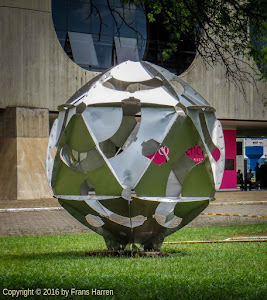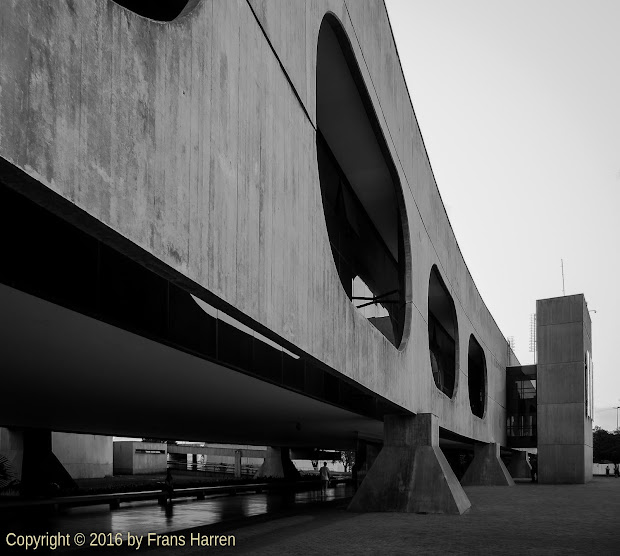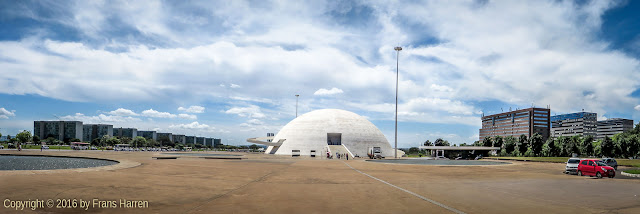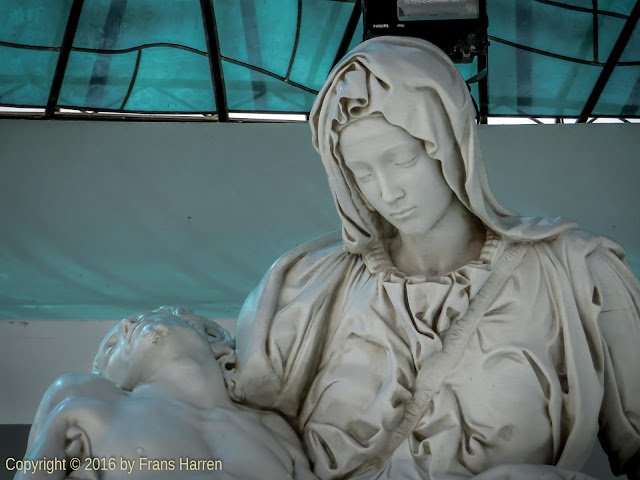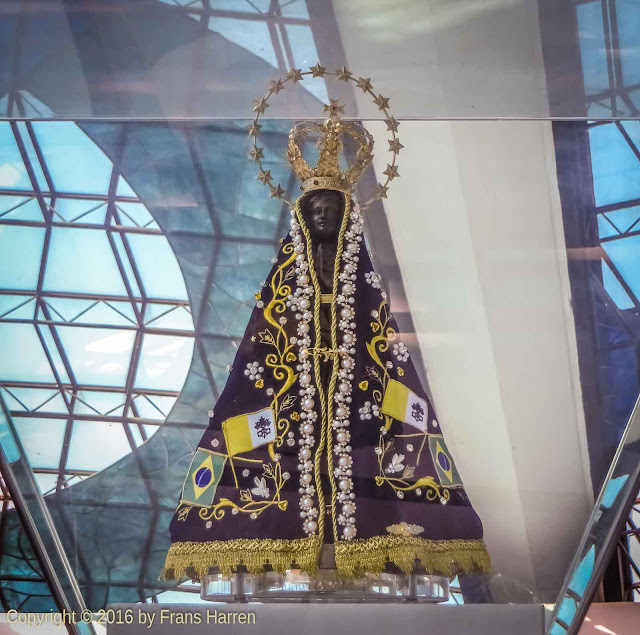From left to right:
- Theater: Teatro Nacional Cláudio Santoro
- Ministeries: Esplanada dos Ministérios
- Cathedral: Catedral Metropolitana Nossa Senhora Aparecida
- Museum: Museu Nacional Honestino Guimarães
- Library: Biblioteca Nacional de Brasília Leonel de Moura Brizola
- Banco do Brasil headquarters
- Busstation: Rodoviária do Plano Piloto
Cláudio Santoro National Theater
The Cláudio Santoro National Theater (Teatro Nacional Cláudio Santoro) is a multi-theater building in Brasília, Brazil. It was designed by Oscar Niemeyer in the Modern architectural style. Construction began on July 30, 1960, and the building was completed in 1966. Built in the shape of a truncated pyramid, it is the largest building in Brasilia designed by Niemeyer specifically for the arts. The building was closed for renovation in 1976, and was reopened on April 21, 1981.
The National Theater is operated by Secretary of Culture of the Federal District and is home to three venues; the 60-seat Alberto Nepomuceno theater, the 407-seat Martins Pena theater, and the 1,407 seat Villa-Lobos theater. The complex also includes an exhibition gallery that is accessible to the public.
Construction of the theater was started on July 30, 1960. The building was structurally complete by January 30, 1961, but construction was then interrupted until early 1966. The Martins-Pena theater was opened on April 21, 1966, and was used for ten years until it was closed on September 4, 1976 during completion of the complex.
Construction was completed by March 1979, and the Villa-Lobos theatre was opened with a concert conducted by Cláudio Santoro. The Martins-Pena theater was reopened on March 7, and the Alberto Nepomuceno theatre was opened on March 8. On December 1, 1979, the entire complex was closed again to complete renovations, and construction began on an annex which would include offices, rehearsal rooms, and galleries.
The complex was reopened on April 21, 1981, and an annex was opened on June 24, 1981. The theatre was renamed Claudio Santoro National Theater on September 1, 1989, in honor of the Brazilian composer and violinist.
See: wikipedia
Monumental Axis
The Monumental Axis ("Eixo Monumental" in Portuguese) is a central avenue in Brasília's city design.
The avenue begins on the National Congress of Brazil building and is considered part of the DF-002 road. Its first section is known as "Ministries Esplanade" ("Esplanada dos Ministérios"), as it is surrounded by ministries buildings. Many important government buildings, monuments and memorials are located on the Monumental Axis.
A common urban legend persists that the Monumental Axis is the widest road in the world, where "[100 to 160] cars can drive side by side". This is untrue, as the road consists of two avenues with six lanes on either side; a total of twelve lanes. However, the street has been featured in the Guinness Book of Records as having the widest central reservation of a dual carriageway in the world.
See: wikipedia
Cathedral of Brasília
The Cathedral of Brasília (Catedral Metropolitana Nossa Senhora Aparecida- "Metropolitan Cathedral of Our Lady of Aparecida") is the Roman Catholic cathedral serving Brasília, Brazil, and serves as the seat of the Archdiocese of Brasília. It was designed by Oscar Niemeyer, and was completed and dedicated on May 31, 1970. The cathedral is a hyperboloid structure constructed from 16 concrete columns, weighing 90 tons each.
In the square access to the cathedral, are four 3-meter tall bronze sculptures representing the four Evangelists created by sculptor Dante Croce in 1968. A 20-meter tall bell tower containing four large bells donated by Spanish residents of Brazil and cast in Miranda de Ebro also stands outside the cathedral, to the right as visitors face the entrance. At the entrance of the cathedral is a pillar with passages from the life of Mary, mother of Jesus, painted by Athos.
A 12-meter wide, 40-centimeter deep reflecting pool surrounds the cathedral roof, helping to cool the cathedral. Visitors pass under this pool when entering the cathedral.
The baptistry is to the left of the entrance, and can be entered either from the cathedral or via a spiral staircase from the entrance plaza. The walls of the oval baptistery are covered in ceramic tiles painted in 1977 by Athos Bulcão. Offices for the Archdiocese of Brasilia were completed in 2007 next to the cathedral. The 3,000-square-metre building connects directly to the cathedral underground.
Visitors enter into the cathedral through a dark tunnel and emerge into a bright space with a glass roof. The outer roof of the cathedral is composed of sixteen pieces of fiberglass, each 10 meters wide at the base and 30 meters long inserted between the concrete pillars. Under this is suspended a 2,000-square-meter stained glass work originally created in 1990 by Marianne Peretti, in shades of blue, green, white, and brown.
Inside the cathedral over the nave are sculptures of three angels, suspended by steel cables. The shortest is 2.22 meters long and weighs 100 kilograms, the middle one 3.4 meters long and weighs 200 kilograms, and the largest is 4.25 meters long and weighs 300 kilograms. The sculptures are by Alfredo Ceschiatti, with the collaboration of Dante Croce in 1970. The altar was donated by Pope Paul VI and the image of the patron saint Our Lady of Aparecida is a replica of the original which is in Aparecida - São Paulo. The Way of the Cross is a work of Di Cavalcanti.
The Cathedral of Brasilia, officially the Metropolitan Cathedral of Our Lady of Aparecida (Catedral Metropolitana Nossa Senhora Aparecida), dedicated to the Blessed Virgin Mary under her title of Our Lady of Aparecida, proclaimed by the Church as Queen and Patroness of Brazil, was designed by the architect Oscar Niemeyer.
This concrete-framed hyperboloid structure, appears with its glass roof to be reaching up, open, to heaven. Most of the cathedral is below ground, with only the 70-meter diameter 42-meter roof of the cathedral, the ovoid roof of the baptistry, and the bell tower visible above ground. The shape of the roof is based in a hyperboloid of revolution with asymmetric sections. The hyperboloid structure consists of 16 identical concrete columns assembled on site. These columns, having hyperbolic section and weighing 90 tonnes, represent two hands moving upwards to heaven.
The cornerstone was laid on September 12, 1958, and the structure was finished on April 21, 1960, with only the roof structure visible above ground. Once the presidential term of Juscelino Kubitschek ended, the big push to finish many structures in Brasilia stalled. Although it is likely that Kubitschek intended the cathedral as an "ecumenical cathedral" to be paid for by the state and open to all faiths, governments after that did not provide funding, and the building was eventually turned over to the Catholic Church to complete. The cathedral was consecrated on October 12, 1968 (still with no roof), and was officially opened by Cardinal D. Eugenio Salles on May 31, 1970. The ovoid baptistry was dedicated on October 5, 1977, and the cathedral was declared a national historic and artistic monument on July 15, 1990.
The cathedral sees some 1,000,000 visitors each year.
See: wikipedia
National Museum Honestino Guimarães
The National Museum Honestino Guimarães is a Brazilian museum in Brasília. The name was given in memory Honestino Guimarães.
The museum, which has a dome shape, and the National Library Leonel de Moura Brizola, were designed by the Brazilian architect Oscar Niemeyer and was inaugurated on 15 of December of 2006, on the day that the architect celebrated its 99 birthday.
The museum has an area of 14,500 square meters and was opened with an exhibition on the work of Niemeyer, "Niemeyer & Niemeyer and Brasília - World Heritage".
The museum and the library form the João Herculino Cultural Complex of the Republic.
See: wikipedia
Biblioteca Nacional de Brasília Leonel de Moura Brizola
The Brasilia National Library (BNB) or National Brasilia Leonel de Moura Brizola Library is a library Brazil, in the city of Brasilia and is part of the Republic Cultural Complex located on the Esplanade of Ministries.
The National Library of Brasilia (BNB) was conceived in the original plan of Brasilia, signed by Lúcio Costa in the late 50s of last century, when the town planner designed the federal capital with Oscar Niemeyer and other architects. The first attempts of the actual creation date back to Decree No. 927-A of 27 April 1962, signed by Prime Minister Tancredo Neves, from the Ministry of Education and Culture, which was commissioned to study measures necessary for the creation, organization and installation of the Library. The decree states, in its first lines, the impossibility of the capital of the Republic without the services of a national library.
The building of the National Library of Brasilia was delivered to the population at the end of 2006, however, without the right conditions for its operation. The project required a process of planning and installation that led to the opening to the public on December 12, 2008.
See: wikipedia
Banco do Brasil
Banco do Brasil S.A. (English: Bank of Brazil) is the largest Brazilian and Latin American bank by assets, and the third by market value. The bank, headquartered in Brasília, was founded in 1808 and is the oldest active bank in Brazil, and one of the oldest banks in continuous operation in the world. It is not the country's central bank.
Banco do Brasil is controlled by the Brazilian government but its stock is traded at the São Paulo Stock Exchange and its management follows standard international banking practices (Basel Accords). Since 2000 it is one of the four most-profitable Brazilian banks (the others being Itaú Unibanco, Bradesco, and Santander Brasil) and holds a strong leadership position in retail banking.
Banco do Brasil was founded by then prince regent John (later King John VI of Portugal) to finance the kingdom's public debt when he moved from Europe to Brazil, in 1808. It went bankrupt two times in history: one at independence in 1821, when John VI returned to Portugal taking with him some of the bank's assets, and the second in 1898.
From 1821 to 1964 Banco do Brasil had sometimes performed tasks that exceeded its role as a traditional commercial bank, issuing currency, having the monopoly of currency exchange transactions and serving as National Treasury holder for the government. Such tasks were gradually given to other governmental institutions, mainly with the creation of the Central Bank of Brazil in 1964 and the separation from the National Treasury in 1987.
From 1992 onwards it was restructured as a commercial bank, using its huge geographic distribution and credit assets to leverage its redesign as a "normal" bank. In the process, tens of thousands of workers were laid off.
After decades of losses financed by the public treasury, the bank became very profitable and is one of the key structures used by the government to finance public programs, like DRS (Sustainable Regional Development).
In November 2013, The Banker ranked Banco de Brasil as the top bank in Brazil based on Tier 1 capital.
See: wikipedia
Rodoviária do Plano Piloto
The main city bus terminal of the Federal District receives about 700,000 passengers per day. In addition to the bus lines circulating within the limits of the Federal District, the terminal also receives long-distance lines, linking Brasilia to neighboring municipalities in Goiás.
It also contains the Central Station of the Brasilia Metro.
See: wikipedia


